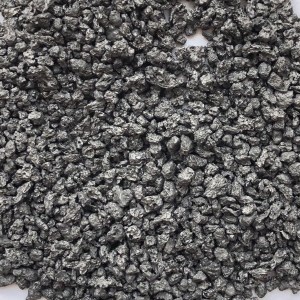carbon raiser
For casting, cast iron, cast steel, castings will have a requirement for carbon, so the carburizer, as the name implies, is to increase the carbon content in molten iron. For example, the commonly used furnace materials in smelting are pig iron, scrap steel, and recycled materials. The carbon content of pig iron is high, but the purchase price is higher than that of scrap steel. Therefore, increasing the amount of scrap steel, reducing the amount of pig iron, and adding carburizers can reduce the cost of castings to a certain extent.
The use of carburizers can not only make up for the burning loss of carbon in the process of iron and steel smelting, ensure the carbon content requirements of specific grades of steel, but also be used for post-furnace adjustments. As an important raw material for melting molten iron in induction furnace, the quality and usage of recarburizer directly affect the state of molten iron.
Adding a specific brand of recarburizer into the ladle after slag removal and degassing treatment can adjust the carbon content in the ladle to achieve the purpose of multiple numbers in one ladle. The materials used in the recarburizer mainly include graphite, graphite-like, electrode block, coke, silicon carbide and other materials. Commonly used electrode blocks and silicon carbide recarburizers have the advantages of high carbon content and strong oxidation resistance, but the production process is relatively complicated and the cost is high; coke powder and graphite are used as recarburizers, and the production cost is lower than that of electrode blocks and other materials , but the content of ash and sulfur is high, the content of carbon is low, and the carburizing effect is not good.
Sponge petroleum coke is produced by delayed coking method. Due to its high content of sulfur and metals, it is usually used as a fuel for calcination, and can also be used as a raw material for calcined petroleum coke. The calcined sponge coke is mainly used in the aluminum industry and as a recarburizer.
Needle petroleum coke is made from raw materials with high aromatic content and low impurity content by delayed coking. This coke has a needle-like structure that is easy to break, sometimes called graphite coke, and is mainly used to make graphite electrodes after calcination.
Granular petroleum coke is in the shape of hard particles, which is made from raw materials with high content of sulfur and asphaltenes by delayed coking, and is mainly used as fuel.
Fluid petroleum coke is produced by continuous coking in a fluidized bed. It is in the form of fine particles, with no directionality in structure, high sulfur content and low volatile matter.
Calcination of petroleum coke is to remove sulfur, moisture, and volatile matter. Calcining raw petroleum coke at 1200-1350°C can make it into substantially pure carbon.
The largest user of calcined petroleum coke is the aluminum industry, 70% of which is used to make anodes for reducing bauxite. Calcined petroleum coke produced in the United States accounts for about 6% of the cast iron recarburizer.










